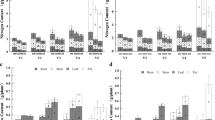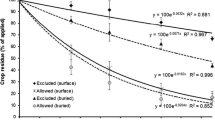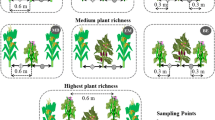Abstract
Millet/cowpea intercropping is a promoted practice in Sub-Saharan agriculture. However, because cowpea is known as a host for plant-parasitic nematodes that may also infect millet, we examined whether intercropping may increase the risk of nematode-mediated millet damage, and if this risk may be controlled by organic amendments. In twelve Senegalese farmers’ fields which had been either non-manured or regularly manured over the past 10 years at least, we assessed the effects of intercropping millet and cowpea on the abundance of free-living and plant-parasitic nematodes, ecological indices, and land equivalent ratios (LER). Six fields were manured, and six non-manured. Each field included four plots: millet and cowpea as pure stands, and two plots with millet intercropped with cowpea sown at two densities. Soil nematofauna was evaluated before sowing and at cowpea flowering. Soil nematofauna was dominated by plant-parasitic nematodes. Before manure application and crop sowing, regularly manured fields had higher structure indices of nematofauna than non-manured ones, and Pratylenchus was almost absent. At crop flowering, abundance of Pratylenchus increased and was drastically higher in pure cowpea (149 individuals 100 g−1 dry soil) than in intercropping and pure millet (18 and 17 individuals 100 g−1 dry soil, respectively), regardless of the manuring regime. Manuring had significant positive effects on various bacterivorous families, on fungivorous and plant-parasitic trophic groups, but not on Pratylenchus. Millet and cowpea yields of manured fields were the highest, regardless of cropping pattern. LER averaged 1.7 and 1.5 in manured and non-manured intercropping, respectively. Regardless of the treatments, ecological indices indicated that the soil food web was undisturbed, with moderate enrichment, and suppressive against crop pests. Intercropping millet with cowpea, even in poorly manured fields and with high cowpea density, constitutes an appropriate way to improve productivity without increasing Pratylenchus pressure in nutrient-poor soils of central Senegal.

Similar content being viewed by others
Data Availability
The authors declare that the data supporting the findings of this study are available within the paper and its supplementary information.
References
Abade CLP, Pedrosa EMR, (...) Guimaraes LMP (2016) Spatial variation of plant-parasitic nematodes in areas under cowpea cultivation after eradication of guava orchard. Nematropica 46:172–187
Atandi JG, Adamtey N, Kiriga AW, (…) Haukeland S (2022) Organic maize and bean farming enhances free-living nematode dynamics in sub-Saharan Africa. Agric Ecosyst Environ 327. https://doi.org/10.1016/j.agee.2021.107846
Bagayoko M, Buerkert A, Lung G, (…) Romheld V (2000) Cereal/legume rotation effects on cereal growth in Sudano-Sahelian West Africa: soil mineral nitrogen, mycorrhizae and nematodes. Plant Soil 218:103–116. https://doi.org/10.1023/A:1014957605852
CEDEAO (2017) Catalogue Régional des Espèces et Variétés Végétales. Available via http://www.insah.org/doc/pdf/Catalogue_Regional_semences_vf_janv_2017.pdf. 1–114. (French).
Chadfield VGA, Hartley SE, Redeker KR (2022) Associational resistance through intercropping reduces yield losses to soil-borne pests and diseases. New Phytol 235:2393–2405. https://doi.org/10.1111/nph.18302
Chang X, Wei D, Zeng Y, (…) Yang W (2022) Maize-soybean relay strip intercropping reshapes the rhizosphere bacterial community and recruits beneficial bacteria to suppress Fusarium root rot of soybean. Front microbiol 13. https://doi.org/10.3389/fmicb.2022.1009689
Ferris H (2010) Contribution of nematodes to the structure and function of the soil food web. J Nematol 42:63–67
Feng C, Sun Z, Zhang L, (...) Wang Q, Xu Z, van der Werf W (2021) Maize/peanut intercropping increases land productivity: A meta-analysis. Field Crop Res 270. https://doi.org/10.1016/j.fcr.2021.108208
Hoogen JVD, Geisen S, Routh D, (…) Crowther TW (2019) Soil nematode abundance and functional group composition at a global scale Nature 572:194–198. https://doi.org/10.1038/s41586-019-1418-6
Jensen ES, Carlsson G, Hauggaard-Nielsen H (2020) Intercropping of grain legumes and cereals improves the use of soil N resources and reduces the requirement for synthetic fertilizer N: a global-scale analysis. Agron Sustain Dev 40:5. https://doi.org/10.1007/s13593-020-0607-x
Jones JT Haegeman A Danchin EG Gaur HS Helder J Jones MG Kikuchi T Manzanilla-López R Palomares-Rius JE Wesemael WM Perry RN (2013) Top 10 plant-parasitic nematodes in molecular plant pathology Mol Plant Pathol 14:946–61. https://doi.org/10.1111/mpp.12057
Leiririo J L, Karuri H, Nyaga JM (2022) Nematode-based soil food web condition in mung bean under semi-arid conditions, J. Agric. Food Res 10:100465, ISSN 2666–1543. https://doi.org/10.1016/j.jafr.2022.100465
Liu T, Chen X, Hu F, (…) Whalen JK (2016) Carbon rich organic fertilizers to increase soil biodiversity: evidence from a meta-analysis of nematode communities Agric Ecosyst Environ 232:199–207. https://doi.org/10.1016/j.agee.2016.07.015
Lu Q, Liu T, Wang N, (…) Zuo Y, (2020) A review of soil nematodes as biological indicators for the assessment of soil health. Front Agr Sci Eng 7: 275–281. https://doi.org/10.15302/J-FASE-2020327
Mokrini F, Viaene N, Waeyenberge L, (…) Moens M (2019) Root-lesion nematodes in cereal fields: importance, distribution, identification, and management strategies. J Plant Dis Prot 126:1–11. https://doi.org/10.1007/s41348-018-0195-z
Mwakilili AD, Mwaikono KS, Herrera SL, (…) Lyantagaye SL (2021) Long-term maize-desmodium intercropping shifts structure and composition of soil microbiome with stronger impact on fungal communities. Plant Soil 467:437–450. https://doi.org/10.1007/s11104-021-05082-w
Nasar J, Khan W, Khan MZ, (…) Maroof SM (2021) Photosynthetic activities and photosynthetic nitrogen use efficiency of maize crop under different planting patterns and nitrogen fertilization. J Soil Sci Plant Nutr 21:2274–2284. https://doi.org/10.1007/s42729-021-00520-1
Nguyen S, Van Chikamatsu S, Kato R, (…) Toyota K (2022) A Biochar improves the efficacy of green manure-based strategies to suppress soybean cyst nematode (Heterodera glycines) and promotes free-living nematode Populations. J Soil Sci Plant Nutr 22:3414–3427. https://doi.org/10.1007/s42729-022-00896-8
Ofori F, Stern WR (1987) Cereal–legume intercropping systems. Adv Agron 41:41–90. https://doi.org/10.1016/S0065-2113(08)60802-0
Peiris PUS, Li Y, Brown P, (…) Xu CY (2020) Efficacy of organic amendments to control Meloidogyne spp. in crops: a systematic review and meta-analysis. J Soils Sediments 20:1584–1598. https://doi.org/10.1007/s11368-019-02498-x
Puissant J, Villenave C, Chauvin C, (…) Trap J, (2021) Quantification of the global impact of agricultural practices on soil nematodes: a meta-analysis. Soil Biol Biochem 161
Rowen E, Tooker JF, Blubaugh CK (2019) Managing fertility with animal waste to promote arthropod pest suppression. Biol Control 134:1049–9644. https://doi.org/10.1016/j.biocontrol.2019.04.012
Sánchez-Moreno S, Ferris H (2018) Nematode ecology and soil health. In: Sikora R, Coyne D, Hallmann J, Timper P (eds) Plant Parasitic Nematodes in Subtropical and Tropical Agriculture. CABI Publishing, Boston USA, pp 62–86
Sangare G, Doka DI, Barage M, Fatondji D (2017) Impact of previous legumes on millet mycorrhization and yields in sandy soil of West African Sahel. J Soil Sci Environ Manage 8:164–189. https://doi.org/10.5897/JSSEM2017.0647
Sarr E, Baujard P, Colonna JP (1989) Etudes sur les nématodes, les nématicides et le niébé (Vigna unguiculata) dans la zone sahélienne du Sénégal. II : Résultats des expérimentations au laboratoire. Revue Nématol 12:265–268 (French)
Sawadogo A, Thio B, Kiemde S, Drabo I, Dabire C, Ouedraogo J, Mullens TR, Ehlers JD, Roberts PA (2009) Distribution and prevalence of parasitic nematodes of Cowpea (Vigna unguiculata) in Burkina Faso. Nematology 41:120–127
Seinhorst JW (1962) Modifications of the elutriation method for extracting nematodes from soil. Nematologica 8:117–128. https://doi.org/10.1163/187529262X00332
Silva FdJ, Ribeiro RC, Xavier AA (…), Neto JAD (2021) The effect of organic compost of Caryocar brasiliense waste against Meloidogyne javanica in two vegetable crops. Nematology 23:1171-1178. https://doi.org/10.1163/15685411-bja10103
Siqueira KMS, Inomoto MM (2008) Pathogenicity and reproductive fitness of Pratylenchus brachyurus on cowpea. Nematology 10:495–500. https://doi.org/10.1163/156854108784513897
Song C, Wang W, Gan Y, (…) Yang W (2022) Growth promotion ability of phosphate-solubilizing bacteria from the soybean rhizosphere under maize–soybean intercropping systems. J Sci Food Agric 102:1430–1442. https://doi.org/10.1002/jsfa.11477
Tang X, Zhang C, Yu Y, (…) Zhang FS (2021) Intercropping legumes and cereals increases phosphorus use efficiency; a meta-analysis. Plant Soil 460:89–104. https://doi.org/10.1007/s11104-020-04768-x
Thoden TC, Korthals GW, Termorshuizen AJ (2011) Organic amendments and their influences on plant-parasitic and free-living nematodes: a promising method for nematode management? Nematology 13:133–153. https://doi.org/10.1163/138855410X541834
Thompson JP, Clewett TG (2021) Investigating the impact of root-lesion nematodes (Pratylenchus thornei) and crown rot (Fusarium pseudograminearum) on diverse cereal cultivars in a conservation farming system. Agronomy 11:867. https://doi.org/10.3390/agronomy11050867
Tounkara A, Clermont-Dauphin C, Affholder F, (…) Cournac L, (2020) Inorganic fertilizer use efficiency of millet crop increased with organic fertilizer application in rainfed agriculture on smallholdings in central Senegal. Agric Ecosyst Environ 294
Trap J, Bonkowski M, Plassard C, (…) Blanchart E (2016) Ecological importance of soil bacterivores for ecosystem functions. Plant Soil 398:1–24. https://doi.org/10.1007/s11104-015-2671-6
Vanstone VA, Hollaway GJ, Stirling G (2008) Managing nematode pests in the southern and western regions of the Australian cereal industry: continuing progress in a challenging environment. Australas Plant Pathol 37:220–234. https://doi.org/10.1071/AP08020
Villenave C, & Cadet P (1998) Interactions of Helicotylenchus dihystera, Pratylenchus pseudopratensis, and Tylenchorhynchus gladiolatus on two plants from the Soudano-Sahelian Zone of West Africa. Nematropica, 31–39
Villenave C, Saj S, Pablo A-L, (…) Bonzi M (2010) Influence of long-term organic and mineral fertilization on soil nematofauna when growing Sorghum bicolor in Burkina Faso. Biol Fertil Soils 46:659–670. https://doi.org/10.1007/s00374-010-0471-y
Wei K, Wang J, Dong Z, (…) Zhu B (2021) The combined application of organic materials and chemical fertilizer mitigates the deterioration of the trophic structure of nematode community by increasing soil N concentration. J Soil Sci Plant Nutr 21:2530–2537. https://doi.org/10.1007/s42729-021-00544-7
Zhong S, Zeng HC (2019) Effect of peanut (Arachis hypogaea L.)/cowpea (Vigna unguiculata L.) intercropping combined with organic mature application on soil microfauna. Geoderma 354:113863. https://doi.org/10.1016/j.geoderma.2019.07.021
Acknowledgements
We thank UMR Eco&Sols (IRD-Montpellier), LMI IESOL (IRD-ISRA Dakar), and Thiès University in Senegal for institutional support. We are grateful to the farmers of the study site (Diohine village) for sharing their field and knowledge during this research.
Funding
This work was supported by:
- IRD ARTS program under the grant n° 913767 K, ISRA
- CGIAR program CRP GLDC
- WAAP Intensification program, Associations
- ANR-13-AGRO-002, CERAO
Author information
Authors and Affiliations
Corresponding author
Ethics declarations
Conflict of Interest
The authors declare no competing interests.
Additional information
Publisher's Note
Springer Nature remains neutral with regard to jurisdictional claims in published maps and institutional affiliations.
Supplementary Information
Below is the link to the electronic supplementary material.
Rights and permissions
Springer Nature or its licensor (e.g. a society or other partner) holds exclusive rights to this article under a publishing agreement with the author(s) or other rightsholder(s); author self-archiving of the accepted manuscript version of this article is solely governed by the terms of such publishing agreement and applicable law.
About this article
Cite this article
Mbengue, M., Tall, L., Diakhate, S. et al. Intercropping Millet with Cowpea Reduces Pratylenchus Abundance and Improves Land Use Efficiency in a Low Input Sub-Saharan Cropping System. J Soil Sci Plant Nutr 24, 1448–1459 (2024). https://doi.org/10.1007/s42729-024-01648-6
Received:
Accepted:
Published:
Issue Date:
DOI: https://doi.org/10.1007/s42729-024-01648-6




